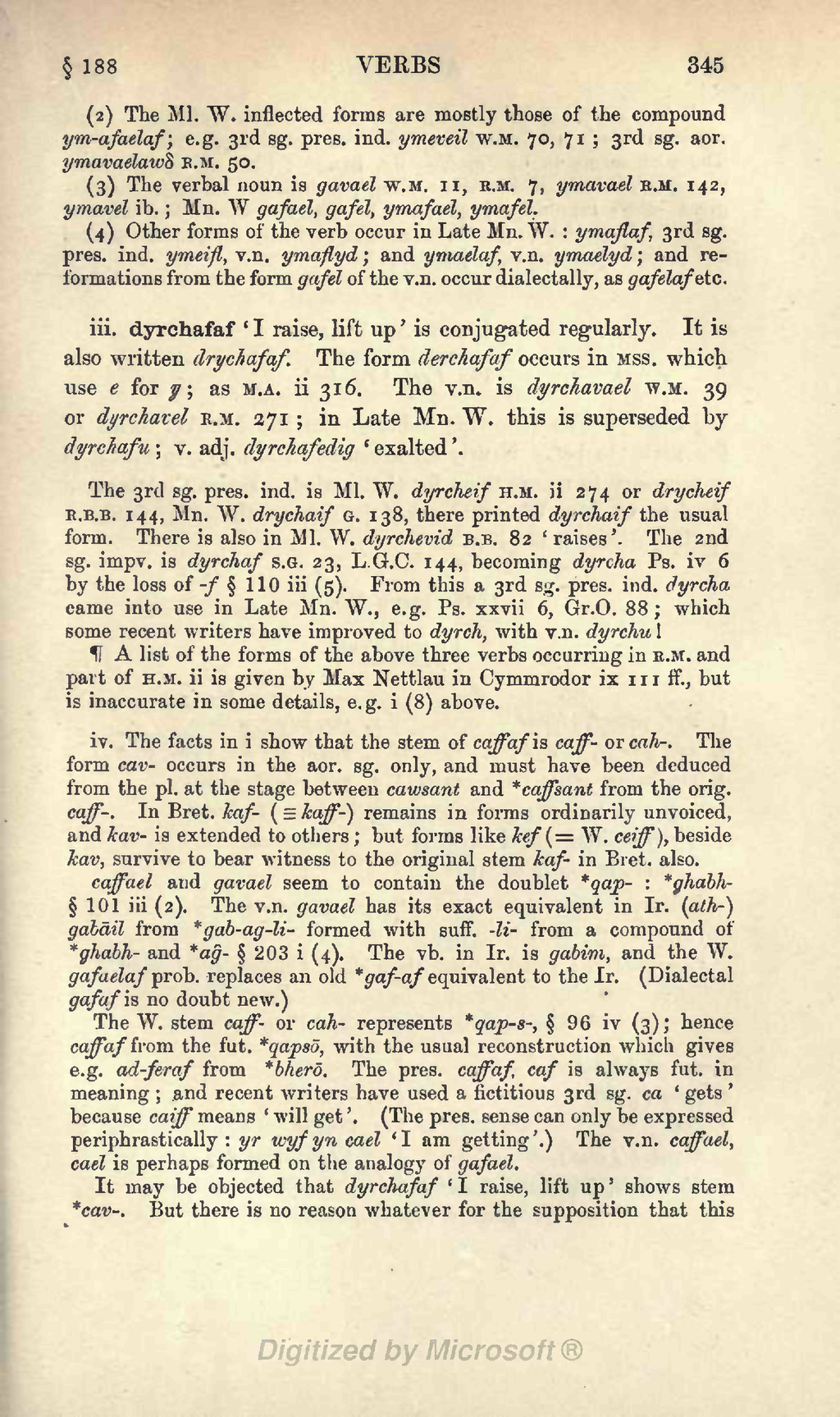(2) The Ml. W. inflected forms are mostly those of the compound ym-afaelaf; e.g. 3rd sg. pres. ind. ymeveil w.m. 70, 71; 3rd sg. aor. ymavaelawẟ r.m. 50.
(3) The verbal noun is gavael w.m. 11, r.m. 7, ymavael r.m. 142, ymavel ib.; Mn. W gafael, gafel, ymafael, ymafel.
(4) Other forms of the verb occur in Late Mn. W.: ymaflaf, 3rd sg. pres. ind. ymeifl, v.n. ymaflyd; and ymaelaf, v.n. ymaelyd; and re-formations from the form gafel of the v.n. occur dialectally, as gafelaf etc.
iii. dyrchafaf ‘I raise, lift up’ is conjugated regularly. It is also written drychafaf. The form derchafaf occurs in mss. which use e for ỿ as m.a. ii 316. The v.n. is dyrchavael w.m. 39 or dyrchavel r.m. 271; in Late Mn. W. this is superseded by dyrchafu; v. adj. dyrchafedig ‘exalted’.
The 3rd sg. pres. ind. is Ml. W. dyrcheif h.m. ii 274 or drycheif r.b.b. 144, Mn. W. drychaif g. 138, there printed dyrchaif the usual form. There is also in Ml. W. dyrchevid b.b. 82 ‘raises’. The 2nd sg. impv. is dyrchaf s.g. 23, L.G.C. 144, becoming dyrcha Ps. iv 6 by the loss of ‑f § 110 iii (5). From this a 3rd sg. pres. ind. dyrcha came into use in Late Mn. W., e.g. Ps. xxvii 6, Gr.O. 88; which some recent writers have improved to dyrch, with v.n. dyrchu!
¶ A list of the forms of the above three verbs occurring in r.m. and part of h.m. ii is given by Max Nettlau in Cymmrodor ix 111 ff., but is inaccurate in some details, e.g. i (8) above.
iv. The facts in i show that the stem of caffaf is caff- or cah‑. The form cav- occurs in the aor. sg. only, and must have been deduced from the pl. at the stage between cawsant and *caffsant from the orig. caff‑. In Bret. kaf- (≡ kaff‑) remains in forms ordinarily unvoiced, and kav- is extended to others; but forms like kef (= W. ceiff), beside kav, survive to bear witness to the original stem kaf- in Bret. also.
caffael and gavael seem to contain the doublet *qap‑: *ꬶhabh- § 101 iii (2). The v.n. gavael has its exact equivalent in Ir. (ath‑)gabāil from *gab-ag-li- formed with suff. ‑li- from a compound of *ꬶhabh- and *ag̑- § 203 i (4). The vb. in Ir. is gabim, and the W. gafaelaf prob. replaces an old *gaf-af equivalent to the Ir. (Dialectal gafaf is no doubt new.)
The W. stem caff- or cah- represents *qap‑s‑, § 96 iv (3); hence caffaf from the fut. *qapsō, with the usual reconstruction which gives e.g. ad-feraf from *bherō. The pres. caffaf, caf is always fut. in meaning; and recent writers have used a fictitious 3rd sg. ca ‘gets’ because caiff means ‘will get’. (The pres. sense can only be expressed periphrastically: yr wyf yn cael ‘I am getting’.) The v.n. caffael, cael is perhaps formed on the analogy of gafael.
It may be objected that dyrchafaf ‘I raise, lift up’ shows stem *cav‑. But there is no reason whatever for the supposition that this